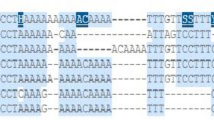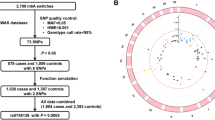Abstract
Background
CDKN1A gene encoding p21 is an important tumour supressor involved in the pathogenesis of cancers. A few studies have been devoted to the association between CDKN1A single nucleotide polymorphisms (SNPs) and esophageal cancer (EC) in China, India and Iran. The aim of this case–control study was to investigate the association of CDKN1A polymorphisms with EC risk in the Turkey population for the first time.
Methods
In the present study, CDKN1A SNPs (rs1801270 C > T, rs1059234 C > A and rs3176352 C > G) were genotyped with the use of TaqMan SNP genotyping assays in 102 patients and 119 controls.
Results
The genotypes and alleles of CDKN1A SNPs were not significantly different among patients and controls. However, TT-genotype and T-allele of the rs1059234, the rs1801270 CC-genotype and rs3176352 G-allele were significantly associated with EC risk for ≤ 55 age (p < 0.05). In those over 55 age, CC-genotype and C-allele of the rs1059234 was significantly associated with EC (p < 0.05). The rs1059234 T-carriers had a higher risk of high globulin level (p = 0.017) and low albumin/globulin ratio (p = 0.019) when compared to non-T carriers (CC). The rs3176352 CC-genotype carriers had a higher risk of esophageal adenocarcinoma (EAC) subtype when compared to CG-genotype carriers and CG-genotype carriers had a higher risk of squamous cell carcinoma (ESCC) subtype (OR/95% CI = 4.00/1.06–15.08, p = 0.04). The rs3176352 CC-genotype is also a risk factor for the higher BMI (p = 0.04) and the higher CA-19–9 level (p = 0.009).
Conclusion
Our study suggests that the CDKN1A polymorphisms may play an important role in EC risk in relation to age. Future studies are needed to validate our findings.


Similar content being viewed by others
Abbreviations
- EC:
-
Esophageal cancer
- qPCR:
-
Real time polymerase chain reaction
- SNP:
-
Single nucleotide polymorphism
- ESCC:
-
Esophageal squamous cell carcinoma
- EAC:
-
Esophageal adenocarcinoma
- EDTA:
-
Ethylenediamine tetra acetic acid
- CA-19–9:
-
Carbohydrate antigen 19–9
- CEA:
-
Carcinoembryogenic antigen
- BMI:
-
Body mass index
References
Ferlay J, Colombet M, Soerjomataram I, Mathers C, Parkin DM, Pineros M, Znaor A, Bray F (2019) Estimating the global cancer incidence and mortality in 2018: globocan sources and methods. Int J Cancer 144:1941–1953
Arnold M, Soerjomataram I, Ferlay J, Forman D (2015) Global incidence of oesophageal cancer by histological subtype in 2012. Gut 64:381–387
Bray F, Ferlay J, Soerjomataram I, Siegel RL, Torre LA, Jemal A (2018) Global cancer statistics 2018: GLOBOCAN estimates of incidence and mortality worldwide for 36 cancers in 185 countries. CA Cancer J Clin 68:394–424
Brown LM, Devesa SS (2002) Epidemiologic trends in esophageal and gastric cancer in the United States. Surg Oncol Clin N Am 11:235–256
Eroğlu A, Aydın Y, Altuntaş B, Gündoğdu B, Yılmaz Ö (2016) The increasing incidence of esophageal squamous cell carcinoma in women in Turkey. Turk J Med Sci 46(5):1443–1448. https://doi.org/10.3906/sag-1504-154
Ilhan M, Erbaydar T, Akdeniz N, Arslan S (2005) Palmoplantar keratoderma is associated with esophagus squamous cell cancer in Van region of Turkey: a case control study. BMC Cancer 5:90. https://doi.org/10.1186/1471-2407-5-90
Lagergren J, Bottai M, Giola S (2021) Patients age and survival after surgery for esophageal cancer. Ann Surg Oncol 28(1):159–166. https://doi.org/10.1245/s10434-020-08653-w
Tian J, Liu C, Liu G, Zuo C, Chen H (2019) Cumulative evidence gor association between genetic polymorphisms and esophageal cancer susceptibility: a review with evidence frım meta-analaysis and genome-wide association studies. Cancer Med 8(3):1289–1305. https://doi.org/10.1002/cam4.1972
Abnet CC, Arnold M, Wei WQ (2018) Epidemiology of esophageal squamous cell carcinoma. Gastroenterology 154(2):360–373
Blagosklonny MV (2002) Are p27 and p21 cytoplasmic oncoproteins? Cell Cycle 1(6):391–393
Cazzalini O, Donà F, Savio M, Tillhon M, Maccario C, Perucca P et al (2010) p21CDKN1A participates in base excision repair by regulating the activity of poly (ADP-ribose) polymerase-1. DNA Repair Amst 9(6):627–635
Cmielová J, Rezácˇová M (2011) p21Cip1/Waf1 protein and its function based on a subcellular localization. J Cell Biochem 112(12):3502–3526. https://doi.org/10.1002/jcb.23296
Georgakilas AG, Martin OA, Bonner WM (2017) p21: a two-faced genome guardian. Trends Mol Med 23(4):310–319. https://doi.org/10.1016/j.molmed.2017.02.001
Li G et al (2005) Genetic polymorphisms of p21 are associated with risk of squamous cell carcinoma of the head and neck. Carcinogenesis 26:1596–1602
Chedid M, Michieli P, Lengel C, Huppi K, Givol D (1994) A single nucleotide substitution at codon 31 (Ser/Arg) defines a polymorphism in a highly conserved region of the p53-inducible gene WAF1/CIP1. Oncogene 9(10):3021–3024
Zheng L, Tang W, Shi Y, Chen S et al (2014) p21 rs3176352 G>C and p73 rs1801173 C>T polymorphisms are associated with an increased risk of esophageal cancer in a Chinese population. PLoS ONE 9(5):e96958. https://doi.org/10.1371/journal.pone.0096958
Taghavi N, Biramijamal F, Abbaszadegan MR et al (2010) P21(waf1/cip1) gene polymorphisms and possible interaction with cigarette smoking in esophageal squamous cell carcinoma in northeastern iran: a preliminary study. Arch Iran Med 13(3):235–242
Bosman FT, Carneiro F, Hruban RH, Theise N (2010) WHO classification of tumours of the digestive system. WHO classification of tumours, vol 3, 4th edn. World Health Organization, Lyon
Gartel AL, Tyner AL (1999) Transcriptional regulation of the p21((WAF1/CIP1)) gene. Exp Cell Res 246:280–289
El-Deiry WS et al (1993) WAF1, a potential mediator of p53 tumor suppression. Cell 75:817–25
Purnomosari D, Raharjo C, Kalim AS, Herviastuti R, Yushan M, Fajar RA, Harris KK, Wahyono A (2019) p21 Ser31Arg and FGFR2 rs2981582 polymorhisms as risk factors for early onset of breast cancer in Yogyakarta, Indonesia. Asian Pac J Cancer Prev 20(11):3305–3309. https://doi.org/10.31557/APJCP.2019.20.11.3305
Yang W, Li Y, Ning T, Cai H, Chen Z, Dong Y, Ke Y (2016) Polymorphisms in the 5’ upstream regulatory region of p21 (WAF1/CIP1) and susceptibility to oesophageal squamous cell carcinoma. Sci Rep 6:22564. https://doi.org/10.1038/srep22564
Lee CH, Wu DC, Lee JM, Wu IC, Goan YG, Kao EL, Huang HL, Chan TF, Chou SH, Chou YP (2007) Carcinogenetic impact of alcohol intake on squamous cell carcinoma risk of the oesophagus in relation to tobacco smoking. Eur J Cancer 43:1188–1199
Taylor PR, Qiao YL, Abnet CC, Wen W, Dawsey SM, Yang CS, Gunter E, Blot WJ, Dong ZW, Mark SD (2003) Prospective study of serum vitamin E levels and esophageal and gastric cancers. J Natl Cancer Inst 95(18):1414–1416. https://doi.org/10.1093/jnci/djg044
Abnet CC, Lai B, Qiao YL, Vogt S, Luo XM, Taylor PR, Dong ZW, Mark SD, Dawsey SM (2005) Zinc concentration in esophageal biopsy specimens measured by x-ray fluorescence and esophageal cancer risk. J Natl Cancer Inst 97:301–306
Kaya Z, Almali N, Karan BM, Gorgisen G (2021) Evaluation of TP53 codon 72 polymorphism in esophageal cancer susceptibility in Eastern Anatolia Region of Turkey. East J Med 26(3):388–395
Celik S, Yılmaz EM, Özden F et al (2015) The relationship between eating and lifestyle habits and cancer in Van Lake region: another endemic region for esophageal and gastric cancers. J Cancer Epidemiol 201:254823
Watanabe M, Otake R, Kozuki R, Toihata T, Takahashi K, Okamura A, Imamura Y (2020) Recent progress in multidisiplinary treatment for patients with esophageal cancer. Surg Today 50(1):12–20. https://doi.org/10.1007/s00595-019-01878-7
Jie L, Zhenzhen L, Quancheng K, Suke S, Yidong L, Suyun W (2015) Association of p21 3’UTR gene polymorphism with cancer risk: evidence from a meta-analysis. Sci Rep 5:13189
Wen J, Ye F, Li S, Huang X, Yang L, Xiao X, Xie X (2015) The practicability of a novel prognostic index (PI) model and comparison with nottingham prognostic index (NPI) in stage I-III breast cancer patients undergoing surgical treatment. PLoS ONE 10(11):e0143537
Li Q, Meng X, Liang L, Xu Y, Cai G, Cai S (2015) High preoperative serum globulin in rectal cancer treated with neoadjunctive chemoradiation therapy is a risk factor for poor outcome. Am J Cancer Res 5(9):2856–2864
Zhang Y, Zhu JY, Zhou LN, Tang M, Chen MB, Tao M (2020) Predicting the prognosis of gastric cancer by albumin/globulin ratio and the prognostic nutritional index. Nutr Cancer 72(4):635–644
Chi J, Xie Q, Jia J, Liu X, Sun J, Chen J, Yi L (2018) Prognostic value of albumin/globulin ratio in survival and lymph node metastasis in patients with cancer: a systematic review and meta-analysis. J Cancer 9(13):2341–2348. https://doi.org/10.7150/jca.24889
Hiro J, Kobayashi M, Ohi M, Araki T, Inoue Y, Mohri Y, Kusunoki M (2017) Clinical burden of preoperative albumin-globulin ratio in esophageal cancer patients. Am J Surg 214(5):891–898
Scarpa M, Noaro G, Saadeh L, Cavallin F, Cagol M, Alfieri R, Plebani M, Castoro C (2015) Esophageal cancer management: preoperative CA19.9 and CEA serum levels may identify occult advanced adenocarcinoma. World J Surg 39(2):424–432
van der Kaaij RT, Voncken FEM, van Dieren JM, Snaebjornsson P, Korse CM, Grootscholten C, Aleman BMP, van Sandick JW (2019) Elevated pretreatment CEA and CA19-9 levels are related to early treatment failure in esophageal adenocarcinoma. Am J Clin Oncol 42(4):345–350
Dai MH, Zhao YP, Cai LX, Zhu Y (2003) Combined detection of K-ras mutation and CA 19–9 level in plasma of patients with pancreatic cancer. Zhonghua Wai Ke Za Zhi 41(5):332–335
He M, Wu C, Xu J, Guo H, Yang H, Zhang X, Sun J, Yu D, Zhou L, Peng T, He Y, Gao Y, Yuan J, Deng Q, Dai X, Tan A, Feng Y, Zhang H, Min X, Yang X, Zhu J, Zhai K, Chang J, Qin X, Tan W, Hu Y, Lang M, Tao S, Li Y, Li Y, Feng J, Li D, Kim ST, Zhang S, Zhang H, Zheng SL, Gui L, Wang Y, Wei S, Wang F, Fang W, Liang Y, Zhai Y, Chen W, Miao X, Zhou G, Hu FB, Lin D, Mo Z, Wu T (2014) A genome wide association study of genetic loci that influence tumour biomarkers cancer antigen 19–9, carcinoembryonic antigen and α fetoprotein and their associations with cancer risk. Gut 63(1):143–151
Fang X, Wei J, He X, Lian J, Han D, An P, Zhou T, Liu S, Wang F, Min J (2018) Quantitative association between body mass index and the risk of cancer: A global Meta-analysis of prospective cohort studies. Int J Cancer 143(7):1595–1603
Lin YC, Hour TC, Tsai YC, Huang SP, Wu WJ, Chen CH, Pu YS, Chung SD, Huang CY (2017) Preliminary evidence of polymorphisms of cell cycle regulatory genes and their roles in urinary tract urothelial cancer susceptibility and prognosis in a Taiwan population. Urol Oncol 35(9):543.e7-543.e16. https://doi.org/10.1016/j.urolonc.2016.08.001
Chen R, Liu S, Ye H, Li J, Du Y, Chen L, Liu X, Ding Y, Li Q, Mao Y, Ai S, Zhang P, Ma W, Yang H (2015) Association of p53 rs1042522, MDM2 rs2279744, and p21 rs1801270 polymorphisms with retinoblastoma risk and invasion in a Chinese population. Sci Rep 5:13300. https://doi.org/10.1038/srep13300
Wang X, Lin Y, Lan F, Yu Y, Ouyang X, Liu W, Xie F, Wang X, Huang Q (2014) BAX and CDKN1A polymorphisms correlated with clinical outcomes of gastric cancer patients treated with postoperative chemotherapy. Med Oncol 31(11):249. https://doi.org/10.1007/s12032-014-0249-4
Carvalho IN, Reis AH, Cabello PH, Vargas FR (2013) Polymorphisms of CDKN1A gene and risk of retinoblastoma. Carcinogenesis 34(12):2774–2777. https://doi.org/10.1093/carcin/bgt308
Acknowledgements
We thank Dr. Can Ates for the advice on the statistical analysis method.
Funding
This work was supported by grants from the Research Foundation of Van Yüzüncü Yıl University (BAP) (TYL-2017–6480).
Author information
Authors and Affiliations
Corresponding author
Ethics declarations
Conflict of interest
The authors declare that they have no conflict of interest.
Ethical approval
The study has been approved by the ethics committee of SBU Van Education and Research Hospital (2017/7).
Consent to participate
Informed consent was obtained from all study participants.
Additional information
Publisher's Note
Springer Nature remains neutral with regard to jurisdictional claims in published maps and institutional affiliations.
Rights and permissions
About this article
Cite this article
Kaya, Z., Karan, B.M. & Almalı, N. CDKN1A (p21 gene) polymorphisms correlates with age in esophageal cancer. Mol Biol Rep 49, 249–258 (2022). https://doi.org/10.1007/s11033-021-06865-1
Received:
Accepted:
Published:
Issue Date:
DOI: https://doi.org/10.1007/s11033-021-06865-1




